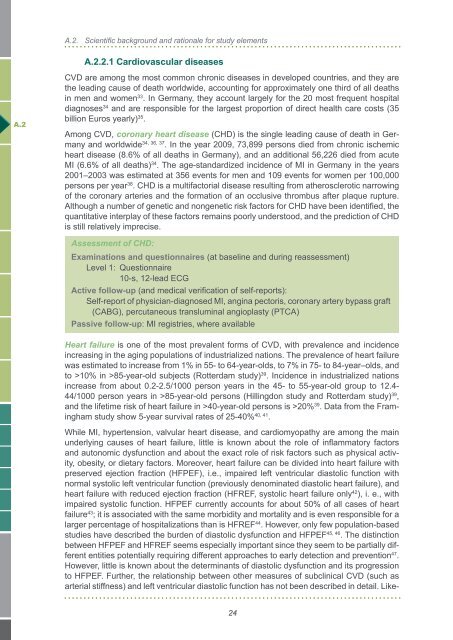Scientific Concept of the National Cohort (status ... - Nationale Kohorte
Scientific Concept of the National Cohort (status ... - Nationale Kohorte
Scientific Concept of the National Cohort (status ... - Nationale Kohorte
Create successful ePaper yourself
Turn your PDF publications into a flip-book with our unique Google optimized e-Paper software.
A.2<br />
A.2. <strong>Scientific</strong> background and rationale for study elements<br />
A.2.2.1 Cardiovascular diseases<br />
CVD are among <strong>the</strong> most common chronic diseases in developed countries, and <strong>the</strong>y are<br />
<strong>the</strong> leading cause <strong>of</strong> death worldwide, accounting for approximately one third <strong>of</strong> all deaths<br />
in men and women 33 . In Germany, <strong>the</strong>y account largely for <strong>the</strong> 20 most frequent hospital<br />
diagnoses 34 and are responsible for <strong>the</strong> largest proportion <strong>of</strong> direct health care costs (35<br />
billion Euros yearly) 35 .<br />
Among CVD, coronary heart disease (CHD) is <strong>the</strong> single leading cause <strong>of</strong> death in Germany<br />
and worldwide 34, 36, 37 . In <strong>the</strong> year 2009, 73,899 persons died from chronic ischemic<br />
heart disease (8.6% <strong>of</strong> all deaths in Germany), and an additional 56,226 died from acute<br />
MI (6.6% <strong>of</strong> all deaths) 34 . The age-standardized incidence <strong>of</strong> MI in Germany in <strong>the</strong> years<br />
2001–2003 was estimated at 356 events for men and 109 events for women per 100,000<br />
persons per year 38 . CHD is a multifactorial disease resulting from a<strong>the</strong>rosclerotic narrowing<br />
<strong>of</strong> <strong>the</strong> coronary arteries and <strong>the</strong> formation <strong>of</strong> an occlusive thrombus after plaque rupture.<br />
Although a number <strong>of</strong> genetic and nongenetic risk factors for CHD have been identified, <strong>the</strong><br />
quantitative interplay <strong>of</strong> <strong>the</strong>se factors remains poorly understood, and <strong>the</strong> prediction <strong>of</strong> CHD<br />
is still relatively imprecise.<br />
Assessment <strong>of</strong> CHD:<br />
Examinations and questionnaires (at baseline and during reassessment)<br />
Level 1: Questionnaire<br />
10-s, 12-lead ECG<br />
Active follow-up (and medical verification <strong>of</strong> self-reports):<br />
Self-report <strong>of</strong> physician-diagnosed MI, angina pectoris, coronary artery bypass graft<br />
(CABG), percutaneous transluminal angioplasty (PTCA)<br />
Passive follow-up: MI registries, where available<br />
Heart failure is one <strong>of</strong> <strong>the</strong> most prevalent forms <strong>of</strong> CVD, with prevalence and incidence<br />
increasing in <strong>the</strong> aging populations <strong>of</strong> industrialized nations. The prevalence <strong>of</strong> heart failure<br />
was estimated to increase from 1% in 55- to 64-year-olds, to 7% in 75- to 84-year–olds, and<br />
to >10% in >85-year-old subjects (Rotterdam study) 39 . Incidence in industrialized nations<br />
increase from about 0.2-2.5/1000 person years in <strong>the</strong> 45- to 55-year-old group to 12.4-<br />
44/1000 person years in >85-year-old persons (Hillingdon study and Rotterdam study) 39 ,<br />
and <strong>the</strong> lifetime risk <strong>of</strong> heart failure in >40-year-old persons is >20% 39 . Data from <strong>the</strong> Framingham<br />
study show 5-year survival rates <strong>of</strong> 25-40% 40, 41 .<br />
While MI, hypertension, valvular heart disease, and cardiomyopathy are among <strong>the</strong> main<br />
underlying causes <strong>of</strong> heart failure, little is known about <strong>the</strong> role <strong>of</strong> inflammatory factors<br />
and autonomic dysfunction and about <strong>the</strong> exact role <strong>of</strong> risk factors such as physical activity,<br />
obesity, or dietary factors. Moreover, heart failure can be divided into heart failure with<br />
preserved ejection fraction (HFPEF), i.e., impaired left ventricular diastolic function with<br />
normal systolic left ventricular function (previously denominated diastolic heart failure), and<br />
heart failure with reduced ejection fraction (HFREF, systolic heart failure only 42 ), i. e., with<br />
impaired systolic function. HFPEF currently accounts for about 50% <strong>of</strong> all cases <strong>of</strong> heart<br />
failure 43 ; it is associated with <strong>the</strong> same morbidity and mortality and is even responsible for a<br />
larger percentage <strong>of</strong> hospitalizations than is HFREF 44 . However, only few population-based<br />
studies have described <strong>the</strong> burden <strong>of</strong> diastolic dysfunction and HFPEF 45, 46 . The distinction<br />
between HFPEF and HFREF seems especially important since <strong>the</strong>y seem to be partially different<br />
entities potentially requiring different approaches to early detection and prevention 47 .<br />
However, little is known about <strong>the</strong> determinants <strong>of</strong> diastolic dysfunction and its progression<br />
to HFPEF. Fur<strong>the</strong>r, <strong>the</strong> relationship between o<strong>the</strong>r measures <strong>of</strong> subclinical CVD (such as<br />
arterial stiffness) and left ventricular diastolic function has not been described in detail. Like-<br />
24



